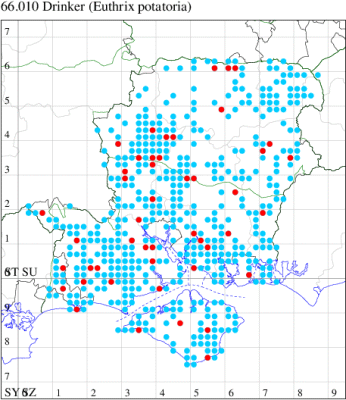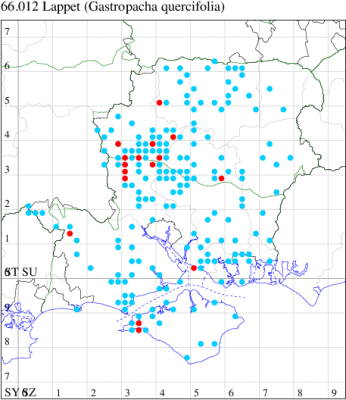2021 Annual Report for: Lasiocampidae / Pinarinae
For species seen in 2021 that had less than or equal to 100 records, full details are included; for more common species, the earliest, latest and highest count by vice-county are shown. The narrative for each species is taken from the main Hantsmoths website, and it is possible that some information on abundance and occurrence can get out of date, as it is impossible to keep up with all changes; however it should give a good introduction to each species. The tables in each species account summarise the previous status, and that for the current year.
For the maps, all records prior to 2021 are shown by a blue dot (the larger the dot, the more recent), with the current year's records shown in red. As previous records are superimposed on any report for 2021, new sites have greater emphasis (i.e. will show as 'more red').
In the species accounts, an asterisk next to a location indicates a new 10km square record; earliest ever dates are highlighted in orange, and latest ever in red. Initials in the species accounts refer to the recorders listed here. Please get in touch if you identify any omissions or errors, in particular if you have records that have yet to be submitted. Details of how to submit records can be found here.
66.010 [B&F: 1640] Drinker Euthrix potatoria (Linnaeus, 1758) - Common
Common on damp grassland, fens, damp woodland, boggy heathland and gardens throughout much of England and Wales. In Hampshire and on the Isle of Wight widespread, but appears much less common than in the past, most frequent in marshy places and riversides, but also in drier grassy terrain. Wingspan male 50-58 mm, female 64-72 mm. Unmistakable. Larva feeds on coarse grasses such as Common Reed, Reed Canary-grass and Cock's-foot.
Records prior to 2021
| Vice County | #Records | #Individuals | First Record | Last Record |
|---|---|---|---|---|
| 10 | 293 | 455 | 1951 | 2020 |
| 11 | 2905 | 4179 | 1947 | 2020 |
| 12 | 983 | 1934 | 1951 | 2020 |
2021 records
| Vice County | #Records | #Individuals | Max Quantity |
|---|---|---|---|
| 10 | 5 | 7 | 2 |
| 11 | 86 | 167 | 26 |
| 12 | 27 | 36 | 7 |

Records by year
Records by week (adult)
Records by week (larval)
Record Summary
VC10: Earliest: Freshwater Bay, 30 Jun, 1 (PBar) Latest: Plaish, Carisbrooke, 24 Jul, 2 (KRyl) Max count: Plaish, Carisbrooke, 24 Jul, 2 (KRyl)
VC11: Earliest: Botley Wood, Whiteley Pastures, 25 May, 1 (SAC) Latest: Botley Wood, 10 Sep, 2 (RJD, MLO, DWal, KJW) Max count: Botley Wood, 13 Aug, 26 (MLO, ADT, DWal, KJW)
VC12: Earliest: Pamber Forest, 28 Jun, 1 (GJD) Latest: Whitehill, 18 Aug, 1 (ASto) Max count: Harewood Forest, 21 Jul, 7 (GCE)
66.012 [B&F: 1642] Lappet Gastropacha quercifolia (Linnaeus, 1758) - Common
Common in hedgerows, scrub, downland, open woodland and gardens throughout southern England and south Wales, north to Cumbria. Widespread and fairly common in Hampshire and on the Isle of Wight. Wingspan 56-98 mm. One of the most remarkably camouflaged of all British moths. Larva feeds on Blackthorn and Hawthorn, and less frequently on Apple, Buckthorn and Alder Buckthorn.
Records prior to 2021
| Vice County | #Records | #Individuals | First Record | Last Record |
|---|---|---|---|---|
| 10 | 67 | 56 | 1951 | 2020 |
| 11 | 194 | 149 | 1948 | 2020 |
| 12 | 190 | 157 | 1940 | 2020 |
2021 records
| Vice County | #Records | #Individuals | Max Quantity |
|---|---|---|---|
| 10 | 2 | 2 | 1 |
| 11 | 12 | 12 | 1 |
| 12 | 7 | 8 | 2 |

Records by year
Records by week (adult)
Records by week (larval)
Record Details
VC10: Freshwater Bay, one, 30 Jun; Freshwater, one, 03 Jul (PBar);
VC11: Fordingbridge, one, 23 Jul (SCT); East Tytherley, one, 14 Jul; Broughton, one, 25 Jul; one, 08 Jul; one, 25 Jul; one, 08 Jul (GCE); one, field observation, 10 Jul (KBet); Houghton, one, 18 Jul; Stockbridge Down NT, one, 18 Jul; Winter Down Copse, Little Somborne, one, 19 Jul; one, 19 Jul (GCE); Brownwich cliffs, one, 16 Jul (MLO, RJD, KJW);
VC12: Over Wallop, two, 16 Jul (CMap); Chilbolton, one, 15 Jul (SLE det. GCE); Crawley, one, 17 Jul; one, 17 Jul; Bullington, one, 16 Jul (GCE); St Mary Bourne, one, 23 Jul (GRut); Hinton Ampner, one, 08 Jul (ASD)